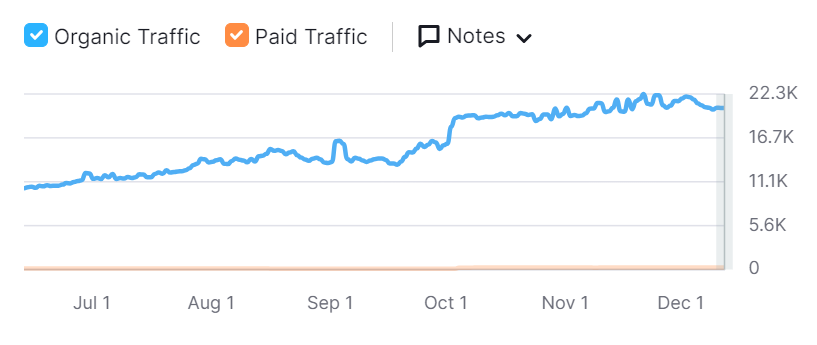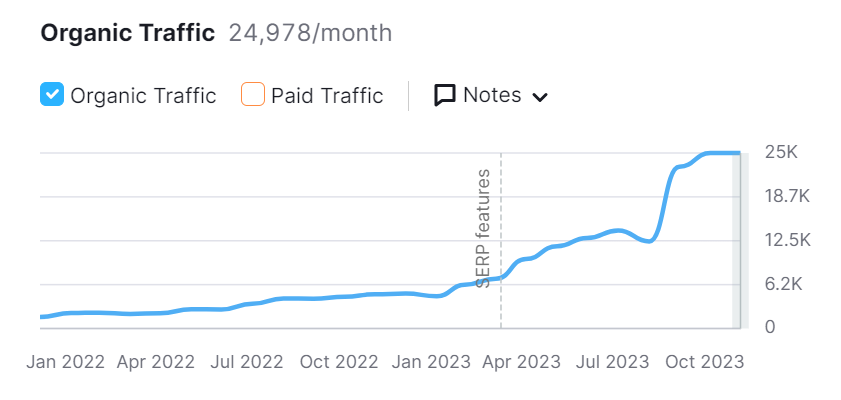2023 was a major year for InLinks. New features, amazing talks and thousands of signups. We have seen some amazing results, so let’s delve deeper into one case study that really excelled this year.
The site:
Even though this site is anonymous, I will give you a bit of context. This client is on our agency plan, meaning they are currently paying less than $200 per month.
The site is a Wikipedia-esque information database, meaning that there’s hundreds of pages that all have equal authority instead of a hierarchical structure that relies on blog posts top bolster a more important parent page. The problems they were facing? The data was not optimally interconnected, meaning that the site was suffering from UX issues along with information processing issues of Google’s knowledge Graph.
Moreover, the site is content heavy, meaning that so many internal linking opportunities were missed in publication. Even if you’re an amazing writer you are likely to miss out on great internal linking opportunities and going back and adding in these internal links manually would take a huge amount of time (and brain capacity) to achieve.
Finally, there was no live webpage schema. This meant that individual concepts were not being made explicit through structured data. Adding this in manually is again an incredibly boring task, and one that this client needed help with through intelligent automation.
Implementation and result overview:
This clients inlinks account was set up with around 350 – 400 pages. The analysis was finished within 20 minutes and the code was put live in July. Here were the incoming results in the following 6 months.

The result? 10k organic traffic increase in 6 months with no paid advertising!
With just a level 4 account (less than 400 pages) this project was able to create:
- 2300 contextually accurate internal links
- Over 300 webpage schemata
- FAQ schema for every relevant page
These were all pushed live onto the site in a single day thanks to the help pf our JS code snippet. This immediately made Google hyper aware of the topic authority that this site holds. Importantly, this did not damage or penalise the site (a question we get asked a lot) and instead provided tonnes o0f useful and profitable information.
A deeper dive into why the set up worked:
Firstly, it was a heavy content site, meaning that the internal linking opportunities were very high. InLinks works best (but not exclusively) with content heavy sites as it can process large amounts of content and sift through for synonyms and sentences that can improve search engine understanding.
The heavy content was also coupled with heavy targeting. It is not always advisable to target every page, but this site was an exception. As it is encyclopaedic in style, the content meant that each page could be pinpointed with a single entity. This meant that, although the client had to make 350-400 manual targets their internal linking/schema output was immense. The process was completed in a day and maintained casually over the 6 months leading up to this, but overall the site gained huge rankings from the equivalent of a single days work.
My site isn’t in this style, what can I do to see these result?
If your site is not enyclopaedic (which it most likely isn’t!) then don’t worry. We have seen similar results for many sites. The main points I wanted to highlight here was that the accurate targeting and heavy content pages like blogs are what makes InLinks tick. If you have an ecommerce site, InLinks will need to see a blog live before we can start adding in this internal linking structures. It can and will automate the hard stuff for you once your content is there!
For context, here is an example of an ecommerce site that put inlinks live at the start of 2023:

Impressive, eh? The theory is to target your most important pages with a single entity, and have the surrounding content pages link towards that page with varied anchor texts and phrases that contribute to the semantic understanding of the concept. It’s a theory that can be applied to any site, so -please do not hesitate to reach out or give it a go for free.
Conclusion:
Yes, this is a brilliant result. Yes, you too can see this result. No, it doesn’t take long and no, it isn’t only for those who have unlimited budgets. InLinks scales with you, so even smaller websites can see these kinds of results.




Leave a Reply
Want to join the discussion?Feel free to contribute!